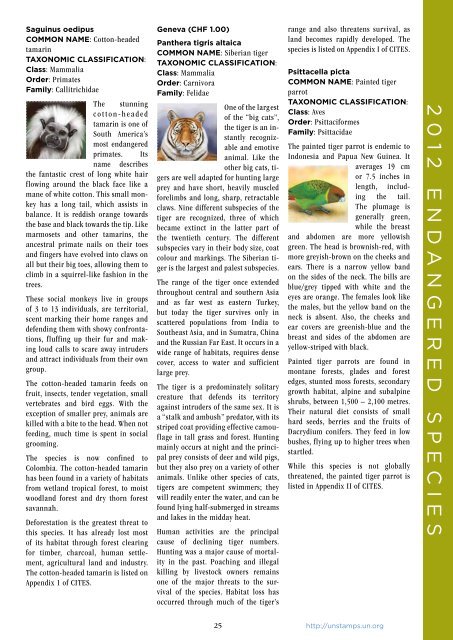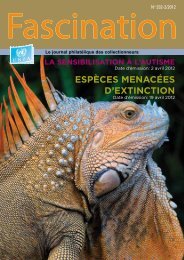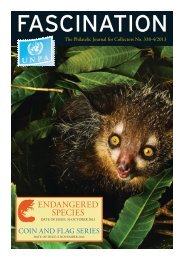endangered species - United Nations Postal Administration - ONU
endangered species - United Nations Postal Administration - ONU
endangered species - United Nations Postal Administration - ONU
You also want an ePaper? Increase the reach of your titles
YUMPU automatically turns print PDFs into web optimized ePapers that Google loves.
Saguinus oedipus<br />
COMMON NAME: Cotton-headed<br />
tamarin<br />
TAXONOMIC CLASSIFICATION:<br />
Class: Mammalia<br />
Order: Primates<br />
Family: Callitrichidae<br />
The stunning<br />
cotton-headed<br />
tamarin is one of<br />
South America’s<br />
most <strong>endangered</strong><br />
primates. Its<br />
name describes<br />
the fantastic crest of long white hair<br />
flowing around the black face like a<br />
mane of white cotton. This small monkey<br />
has a long tail, which assists in<br />
balance. It is reddish orange towards<br />
the base and black towards the tip. Like<br />
marmosets and other tamarins, the<br />
ancestral primate nails on their toes<br />
and fingers have evolved into claws on<br />
all but their big toes, allowing them to<br />
climb in a squirrel-like fashion in the<br />
trees.<br />
These social monkeys live in groups<br />
of 3 to 13 individuals, are territorial,<br />
scent marking their home ranges and<br />
defending them with showy confrontations,<br />
fluffing up their fur and making<br />
loud calls to scare away intruders<br />
and attract individuals from their own<br />
group.<br />
The cotton-headed tamarin feeds on<br />
fruit, insects, tender vegetation, small<br />
vertebrates and bird eggs. With the<br />
exception of smaller prey, animals are<br />
killed with a bite to the head. When not<br />
feeding, much time is spent in social<br />
grooming.<br />
The <strong>species</strong> is now confined to<br />
Colombia. The cotton-headed tamarin<br />
has been found in a variety of habitats<br />
from wetland tropical forest, to moist<br />
woodland forest and dry thorn forest<br />
savannah.<br />
Deforestation is the greatest threat to<br />
this <strong>species</strong>. It has already lost most<br />
of its habitat through forest clearing<br />
for timber, charcoal, human settlement,<br />
agricultural land and industry.<br />
The cotton-headed tamarin is listed on<br />
Appendix 1 of CITES.<br />
Geneva (CHF 1.00)<br />
Panthera tigris altaica<br />
COMMON NAME: Siberian tiger<br />
TAXONOMIC CLASSIFICATION:<br />
Class: Mammalia<br />
Order: Carnivora<br />
Family: Felidae<br />
One of the larg est<br />
of the “big cats”,<br />
the tiger is an instantly<br />
recognizable<br />
and emotive<br />
animal. Like the<br />
other big cats, tigers<br />
are well adapted for hunting large<br />
prey and have short, heavily muscled<br />
forelimbs and long, sharp, retractable<br />
claws. Nine different sub<strong>species</strong> of the<br />
tiger are recognized, three of which<br />
became extinct in the latter part of<br />
the twentieth century. The different<br />
sub<strong>species</strong> vary in their body size, coat<br />
colour and markings. The Siberian tiger<br />
is the largest and palest sub<strong>species</strong>.<br />
The range of the tiger once extended<br />
throughout central and southern Asia<br />
and as far west as eastern Turkey,<br />
but today the tiger survives only in<br />
scattered populations from India to<br />
Southeast Asia, and in Sumatra, China<br />
and the Russian Far East. It occurs in a<br />
wide range of habitats, requires dense<br />
cover, access to water and sufficient<br />
large prey.<br />
The tiger is a predominately solitary<br />
creature that defends its territory<br />
against intruders of the same sex. It is<br />
a “stalk and ambush” predator, with its<br />
striped coat providing effective camouflage<br />
in tall grass and forest. Hunting<br />
mainly occurs at night and the principal<br />
prey consists of deer and wild pigs,<br />
but they also prey on a variety of other<br />
animals. Unlike other <strong>species</strong> of cats,<br />
tigers are competent swimmers; they<br />
will readily enter the water, and can be<br />
found lying half-submerged in streams<br />
and lakes in the midday heat.<br />
Human activities are the principal<br />
cause of declining tiger numbers.<br />
Hunting was a major cause of mortality<br />
in the past. Poaching and illegal<br />
killing by livestock owners remains<br />
one of the major threats to the survival<br />
of the <strong>species</strong>. Habitat loss has<br />
occurred through much of the tiger’s<br />
range and also threatens survival, as<br />
land becomes rapidly developed. The<br />
<strong>species</strong> is listed on Appendix I of CITES.<br />
Psittacella picta<br />
COMMON NAME: Painted tiger<br />
parrot<br />
TAXONOMIC CLASSIFICATION:<br />
Class: Aves<br />
Order: Psittaciformes<br />
Family: Psittacidae<br />
The painted tiger parrot is endemic to<br />
Indonesia and Papua New Guinea. It<br />
averages 19 cm<br />
or 7.5 inches in<br />
length, including<br />
the tail.<br />
The plumage is<br />
generally green,<br />
while the breast<br />
and abdomen are more yellowish<br />
green. The head is brownish-red, with<br />
more greyish-brown on the cheeks and<br />
ears. There is a narrow yellow band<br />
on the sides of the neck. The bills are<br />
blue/grey tipped with white and the<br />
eyes are orange. The females look like<br />
the males, but the yellow band on the<br />
neck is absent. Also, the cheeks and<br />
ear covers are greenish-blue and the<br />
breast and sides of the abdomen are<br />
yellow-striped with black.<br />
Painted tiger parrots are found in<br />
montane forests, glades and forest<br />
edges, stunted moss forests, secondary<br />
growth habitat, alpine and subalpine<br />
shrubs, between 1,500 – 2,100 metres.<br />
Their natural diet consists of small<br />
hard seeds, berries and the fruits of<br />
Dacrydium conifers. They feed in low<br />
bushes, flying up to higher trees when<br />
startled.<br />
While this <strong>species</strong> is not globally<br />
threatened, the painted tiger parrot is<br />
listed in Appendix II of CITES.<br />
2012 ENDANGERED SPECIES<br />
25 http://unstamps.un.org
















